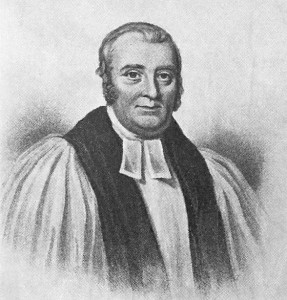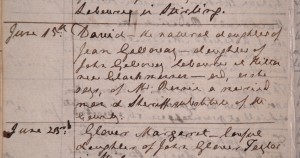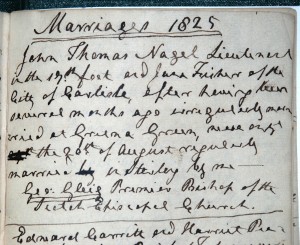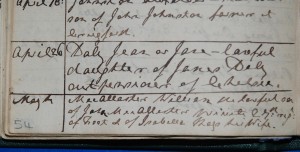The Marriage and Baptism Register of Holy Trinity Church, Stirling is a remarkable record for many reasons. The register was created after long period of uncertainty and repression for Episcopalians. In the 18th Century, Episcopalians had sided with the Jacobites in the 1715 uprising. This transgression in the eyes of the Government led to the passing of the Penal Act of 1719.
The Penal Act prohibited the Episcopalian clergy from ministering in the company of more than nine people in addition to their own family. Moreover, a six month prison sentence was imposed on those who would not pray for the Hanoverian King. Nearly all Episcopalian priests still in possession of parish churches were removed. At this point, congregational meetings were taking place in private houses.
In 1787, the Reverend George Gleig had taken over from the previous minister, the Reverend James Cheyne. Rev. George Gleig, born in Stonehaven in 1753, was a minister in Stirling for 56 years and retired in 1831. After studying at King’s College, Aberdeen, he also undertook the charge of churches at Crail and Pittenweem.
Despite a rise in tolerance and the repeal of the Penal Act in 1792, Rev. Gleig would continue to minister in private meeting houses. It wasn’t until 1804 and the unification of the Stirling Qualified Chapel with Gleig’s Barton Street church that formal records begin to appear.
The register of Baptisms and Marriages was kept solely by Rev. George Gleig in his rather idiosyncratic handwriting. He was in the habit of making rather full notes about the people that he minstered to. For family historians, records like this can provide a wealth of information.
An example can be found in 1815. The register frequently records some children as ‘lawful’ and others as ‘natural’. The term ‘natural’ was used to indicate an illegitimate birth. ‘Lawful’ was used to indicate that children were born within marriage, the term indicating that they were due their rights within the law to inherit property.
It reads:
‘June 15th
David – the natural daughter of
Jean Galloway – daughter of
John Galloway labourer at Milton
near Clackmannan – and, or she
says, of Mr Rennie, a married
man & Sheriff-substitute of the
County’
Marriages were also recorded in the register. An interesting example can be found in 1825 when an entry describes a couple who were married ‘irregularly’ at Gretna Green. This was John Thomas Nagel, Lieutenant, and Jean Fisher of the City of Carlisle.
Their ‘irregular’ marriage was in fact perfectly legal and recognised by Scots Law. It was done by cohabitation and repute, betrothal and consummation or the exchange of promises before witnesses. The couple were married again in church by Rev. George Gleig. The records of Holy Trinity Church include many that relate to soldiers like John Nagel, who were stationed at Stirling Castle. Many of the soldiers were English, and the Episcopal Church was seen as the nearest they could get to the Anglican Church.
Another record of baptism reveals the details of a Chelsea Pensioner. On 26th April 1815 there is a record of baptism for Jean or Jane Daly – ‘lawful daughter of James Daly out pensioner of Chelsea’. An out-pensioner was a former soldier who had been injured in service, or who had served for more than 20 years. They were eligible for a pension from the Royal Hospital, Chelsea.
Owing to a lack space, those soldiers who could not be housed in the building itself were termed ‘out-pensioners’ and would receiving their pension from the Royal Hospital but living outside it.



